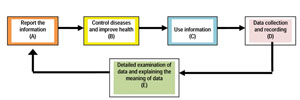Self-Assessment Questions (SAQs) for Study Session 40
Now that you have completed this study session, you can assess how well you have achieved its Learning Outcomes by answering these questions. Write your answers in your Study Diary and discuss them with your Tutor at the next Study Support Meeting. You can check your answers with the Notes on the Self-Assessment Questions at the end of this Module.
SAQ 40.1 (tests Learning Outcomes 40.1, 40.2 and 40.4)
Look at Figure 40.8 below. The surveillance activities have been arranged in the wrong order! List the letters from the boxes in the correct order in which these activities should be carried out.
Answer
The correct order of surveillance activities should be: D, E, A, C and B (refer to Figure 40.1).
SAQ 40.2 (tests Learning Outcomes 40.1, 40.2, 40.3 and 40.4)
Which of the following statements is false? In each case, state why it is incorrect.
A During surveillance in your community, you should always collect as much information as possible, even if you do not use it.
B One of the major purposes of public health surveillance is to detect an epidemic before it can spread very far.
C A good surveillance system uses passive and active surveillance methods to collect and report the most complete data.
D Regular recoding and reporting of public health data is not essential in a high quality surveillance system.
E Active surveillance covers many more diseases compared to passive surveillance.
Answer
A is false. You should only collect data which is useful for the control of communicable diseases.
B is true. Detection of an epidemic is one of the major purposes of surveillance. Surveillance can also be used to assess the magnitude of health problems, to allocate resources based on disease burdens and to evaluate progress of activities by the health facilities.
C is true. A combination of active and passive surveillance is one of the indicators of a high quality surveillance system.
D is false. Regular recording and reporting is one of the essential elements of a surveillance system. Without proper recording and reporting, action against communicable diseases cannot be taken.
E is false. Active surveillance covers specific diseases (not all diseases), unlike a passive surveillance system.
SAQ 40.3 (tests Learning Outcomes 40.1, 40.2, 40.3 and 40.4)
In 2010, the District Health Office asked you to visit all households in your village to check for the presence of a cough lasting more than two weeks in adults (that is, people aged 15 years or older). The total adult population was 4,000 people in that year. Following this request, you visited all households and identified 100 people who had a cough lasting more than two weeks. Of these 100 people, 10 had a confirmed diagnosis of tuberculosis (TB) after laboratory investigation.
- a.What kind of surveillance did you conduct in the example above?
- b.Calculate the incidence rate of tuberculosis in adults in your village.
Answer
- a.Finding cases of TB through house-to-house visits based on the recommendation of the District Health Office is an example of active surveillance.
- b.In the total adult population of 4,000, there were 10 confirmed cases of TB. To calculate the incidence rate, divide 10 by 4,000 and multiply the result by 1,000, to express the incidence rate per 1,000 of the adult population.

Therefore, the incidence rate of TB in 2010 in this community was 1 case per 1,000 population.
Summary of Study Session 40

